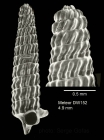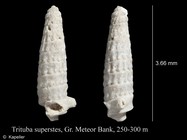WoRMS taxon details
Trituba superstes (Bouchet & Fechter, 1981)
180932 (urn:lsid:marinespecies.org:taxname:180932)
accepted
Species
Triforis superstes Bouchet & Fechter, 1981 · unaccepted (original combination)
marine
(of Triforis superstes Bouchet & Fechter, 1981) Bouchet P. & Fechter R., 1981. Two recent <i>Triforis</i> from the eastern Atlantic. <i>Archiv für Molluskenkunde</i> 111: 165-170.
page(s): 165-172 [details] Available for editors [request]
[request]
page(s): 165-172 [details] Available for editors
Note Great Meteor seamount, 29º48’N -...
From editor or global species database
Type locality Great Meteor seamount, 29º48’N - 28º23’W, 300-310 m. [details]
Distribution Great Meteor seamount, moderately common in 330-470 m; endemic.
Distribution Great Meteor seamount, moderately common in 330-470 m; endemic. [details]
MolluscaBase eds. (2024). MolluscaBase. Trituba superstes (Bouchet & Fechter, 1981). Accessed through: World Register of Marine Species at: https://www.marinespecies.org/aphia.php?p=taxdetails&id=180932 on 2024-11-22
Date
action
by
![]() The webpage text is licensed under a Creative Commons Attribution 4.0 License
The webpage text is licensed under a Creative Commons Attribution 4.0 License
original description
(of Triforis superstes Bouchet & Fechter, 1981) Bouchet P. & Fechter R., 1981. Two recent <i>Triforis</i> from the eastern Atlantic. <i>Archiv für Molluskenkunde</i> 111: 165-170.
page(s): 165-172 [details] Available for editors [request]
[request]
basis of record Check List of European Marine Mollusca (CLEMAM). , available online at http://www.somali.asso.fr/clemam/index.clemam.html [details]
additional source Gofas, S. (2003). An endemic radiation of <i>Trituba</i> (Mollusca, Gastropoda) on the North Atlantic seamounts. <em>American Malacological Bulletin.</em> 17(1-2): 45-63.
page(s): 47-49 [details] Available for editors [request]
[request]
page(s): 165-172 [details] Available for editors
basis of record Check List of European Marine Mollusca (CLEMAM). , available online at http://www.somali.asso.fr/clemam/index.clemam.html [details]
additional source Gofas, S. (2003). An endemic radiation of <i>Trituba</i> (Mollusca, Gastropoda) on the North Atlantic seamounts. <em>American Malacological Bulletin.</em> 17(1-2): 45-63.
page(s): 47-49 [details] Available for editors
 Present
Present  Present in aphia/obis/gbif/idigbio
Present in aphia/obis/gbif/idigbio  Inaccurate
Inaccurate  Introduced: alien
Introduced: alien  Containing type locality
Containing type locality
From editor or global species database
Biology The type of larval development is not known from direct evidence, but is inferred to be intracapsular from similarity of the larval whorls with those of Cerithiella (see Bouchet and Warén, 1993). There is a multispiral protoconch, but no clear separation protoconch 1/protoconch 2 nor protoconch 2/teleoconch. [details]Diagnosis Shell up to 6.8 x 1.4 mm, turriculate, solid, white, with 12-15 whorls. Protoconch ca. 2.5-3 whorls, with maximum diameter 0.75 mm, the nucleus quite sunken in the following whorl, resulting in a very blunt apex; protoconch whorls strongly and evenly convex, sculptured with strong and elevated, sharp, widely spaced ribs starting on the very first whorl, slightly oblique on the first and second whorls, still more oblique on the third. Teleoconch whorls sculptured with quite strong, slightly oblique ribs on which there is a subsutural and a suprasutural bulge, separated by a broad depression; the suprasutural bulges bordered adapically by a faint spiral line. Body whorl hardly narrowing; its abapical surface smooth and circled by a faint keel on which the ribs terminate. Aperture with a continuous, moderately flaring peristome. Siphonal canal moderately long, narrowing towards outer opening, inside with columellar and labial lamellae set widely apart. Anal canal similar in size and shape to the siphonal, moderately curved, pointing sidewards.
Trituba fallax Gofas, 2003, from Hyères seamount, is similar in teleoconch sculpture but grows larger, has a proportionally much shorter anal canal and has the first protoconch whorl more protruding, making the apex not so blunt. [details]
Distribution Great Meteor seamount, moderately common in 330-470 m; endemic. [details]
Type locality Great Meteor seamount, 29º48’N - 28º23’W, 300-310 m. [details]
Unreviewed
Habitat Known from seamounts and knolls [details]



